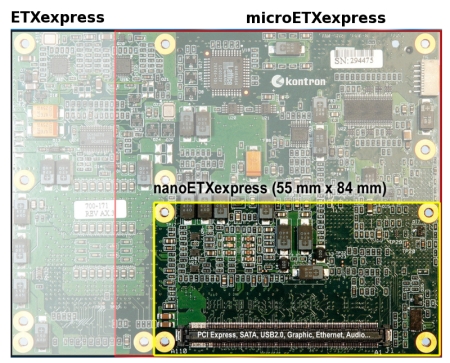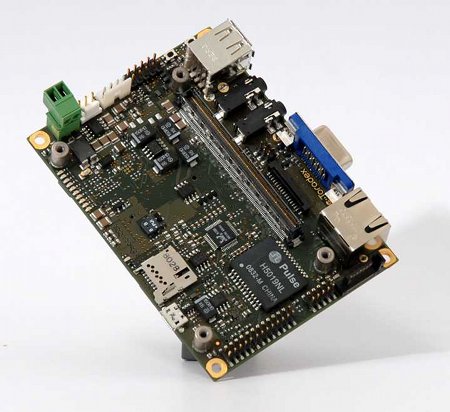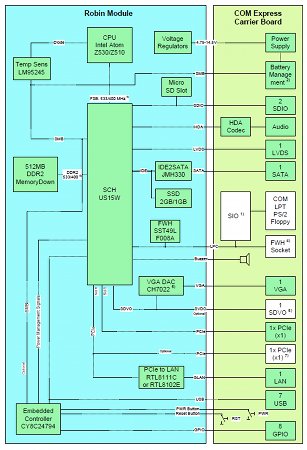Credit-card-sized COM gets carrier board
Dec 9, 2009 — by LinuxDevices Staff — from the LinuxDevices Archive — 6 viewsToradex announced a Pico-ITX-sized carrier board intended for a previously released, credit-card-sized COM (computer on module). The “Daisy” accepts the company's Robin module, adding real-world interfaces that include VGA and TV output, 7:1 audio, SATA, five USB ports, and a microSD expansion slot, the company says.
Toradex's Daisy is a carrier board specifically designed for the company's Robin, a COM it released last February (see later in this story for background). The Robin uses the 84 x 55mm form factor (below) that was originally introduced by Kontron as nanoETXexpress remaned "nano COM express" by Toradex, and subsequently submitted to the PICMG (PCI Industrial Computer Manufacturers Group) under the proposed neutral name, COM Express Ultra.

A comparison of COM form factors
By whatever name, nanoETXexpress uses a Type I Com Express pinout, sending almost all its signals over a single 220-pin connector. Optionally, a 30-pin Hirose FH12-compatible connector can be located on the side of a module, providing access to SDVO signals.

Toradex's Daisy
(Click to enlarge)
Toradex's Daisy, pictured above, doesn't appear to sport the SDVO connector, but of course does have the standard 220-pin connector, ready to accept the Robin. According to Toradex, the Pico-ITX-sized board includes a gigabit Ethernet port, a VGA port, a SATA port, TV output, LVDS, and eight GPIOs.
While Toradex's spec sheet and photo make it less than totally clear which signals are provided with 3.5mm jacks and which are carried via headers, the Daisy is said to support 7:1 audio. The carrier board also includes a microSD expansion slot, (supplementing the one that is already present on the Robin itself) and a Mini PCIe slot, according to the company.
Toradex's Robin
 Toradex's Robin (right) is touted as offering "high performance computing with low power consumption." It uses Intel's 1.1GHz Atom Z510 and 1.6GHz Z530 CPUs, paired, as ever, with the chipmaker's comparatively large SCH US15W companion chip.
Toradex's Robin (right) is touted as offering "high performance computing with low power consumption." It uses Intel's 1.1GHz Atom Z510 and 1.6GHz Z530 CPUs, paired, as ever, with the chipmaker's comparatively large SCH US15W companion chip.
The Z510 Robin has a 400MHz frontside bus, while the Z530 Robin gets a 533MHz frontside bus. The Z530 Atom processor also offers hyper-threading, whereas the Z510 does not, notes Toradex. The Robin Z510 uses from 3.5 to 5.0 Watts, while the Robin Z530 uses from 5.1 to 7.6 Watts, the company adds.

A block diagram for Toradex's Robin modules
(Click to enlarge)
The little module is provided with 512MB of soldered-on DDR2 RAM. It also includes onboard flash storage — 1GB in the case of the Robin Z510, and 2GB in the case of the Robin Z530 — plus a microSD slot, for additional memory.
Connections to the outside world are made by both a COM Express connector, on the back of the module, and a 30-pin FFC (flat flexible cable) connector, on the front. According to Toradex, this FFC connector provides access to an additional SDIO channel, supplementing the one already available via COM Express.
In addition to SDIO, interfaces on the Robin include PCIe x1, ExpressCard, gigabit Ethernet, high definition audio, SATA, seven USB ports, VGA, TV output, and LVDS, with support for displays up to 1366 x 768 pixels in size. Via USB, the modules can also offer eight GPIOs as well as I2C, says Toradex.
Toradex offers a couple of build options for "high volume" customers. The Ethernet controller on the Robin can be replaced by a second PCIe x 1 interface, while the VGA video output can be replaced by SDVO, according to the company.
Features and specifications listed by Toradex for the combination of the Robin Z510 or Z530 and the Daisy include:
- Processor — Intel Atom Z510 (1.1GHz) or Z530 (1.6GHz)
- Memory — 512MB of soldered-on DDR2 RAM, and 1GB (Z510) or 2GB (Z530) of flash storage
- Storage — 2 x microSD slot (1 x on module, 1 x on carrier board)
- Expansion — Mini PCIe slot (on carrier board)
- Display — Supports VGA, TV output, and LVDS displays
- Networking — Gigabit Ethernet
- Other I/O:
- 5 x USB 2.0
- 1 x SATA
- 7:1 audio
- 8 x GPIO
- Power consumption (module alone):
- 5.1 to 7.6 Watts, Z530
- 3.5 to 5.0 Watts, Z510
- Power supply — 12VDC, 5 to 100 Watts
- Dimensions:
- Module — 3.3 x 2.15 inches (84 x 55mm)
- Carrier board — 3.93 x 2.83 inches (100 x 72mm)
Availability
Toradex says the Daisy, along with the Robin Z530 and Robin Z510, is compatible with Linux, Windows XP Embedded, Windows XP, Windows Vista, Windows CE 6.0, and VxWorks.
According to Toradex, the devices are available now. Quantity one pricing for the Robin Z530 is 179 Euros (about $263), 129 Euros (about $189) for the Robin Z510, and 90 Euros (about $132) for the Daisy, the company says.
Further information, including pricing for multiple units, may be found on the company's website, here.
This article was originally published on LinuxDevices.com and has been donated to the open source community by QuinStreet Inc. Please visit LinuxToday.com for up-to-date news and articles about Linux and open source.